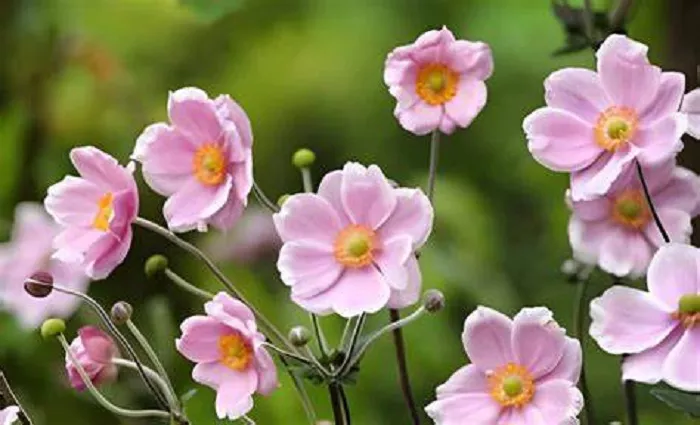In the tapestry of nature’s beauty, few flowers captivate the imagination quite like the anemone. With its delicate petals and vibrant hues, the anemone has long been a symbol of profound meaning across cultures and centuries. From ancient myths to modern gardens, this flower holds a special place in the hearts of those who appreciate its elegance and the stories it tells.
Anemone: A Flower with a Rich History
The anemone flower, with its origins in the Mediterranean region, has been a part of human history for millennia. Its name is derived from the Greek word “anemos,” meaning “wind,” a nod to the way its petals seem to dance in the breeze. This connection to the wind has imbued the anemone with a sense of movement and change, making it a symbol of life’s fleeting moments and the beauty that can be found in impermanence.
Ancient Legends and Symbolism
In Greek mythology, the anemone is closely linked to the story of Adonis, the beautiful youth loved by both Aphrodite, the goddess of love, and Persephone, the queen of the underworld. When Adonis was fatally wounded by a wild boar, Aphrodite’s tears mingled with his blood, giving rise to the first anemones. Thus, the flower became a symbol of love, loss, and the fragility of life. It represents the deep sorrow of parting and the enduring memory of those we hold dear.
Cultural Significance Across the Globe
Beyond its mythological roots, the anemone has taken on various symbolic meanings in different cultures. In Victorian England, where the language of flowers was highly developed, the anemone was often associated with anticipation and expectation. It was given as a gift to express hope for the future and to convey the excitement of new beginnings.
In Chinese culture, the anemone is seen as a symbol of bad luck or misfortune, a stark contrast to its more positive connotations in the West. However, it is also recognized for its beauty and is sometimes used in traditional medicine for its healing properties.
The Allure of Anemone in Modern Gardens
Today, the anemone continues to enchant gardeners and flower enthusiasts alike. Its wide range of colors, from the softest pinks to the boldest reds and purples, makes it a versatile addition to any garden. The anemone’s ability to thrive in a variety of climates and soil conditions has also contributed to its popularity.
Planting and Caring for Anemones
To grow anemones successfully, it is essential to choose the right variety for your climate. Most anemones prefer well-drained soil and partial to full sun. They can be planted in the fall for a spring bloom or in the spring for a summer display. Regular watering and occasional fertilization will help ensure healthy growth and vibrant blooms.
Anemone Varieties to Explore
There are numerous anemone varieties to choose from, each with its own unique characteristics. The Anemone coronaria, also known as the poppy anemone, features large, showy flowers that are perfect for cutting and bringing indoors. The Anemone blanda, or windflower, is a smaller, more delicate variety that spreads easily and creates a carpet of color in early spring.
Anemone in Art and Literature
The anemone’s beauty and symbolic significance have made it a popular subject in art and literature. Artists such as Claude Monet and Vincent van Gogh have captured its delicate form in their paintings, while poets and writers have used it as a metaphor for the transient nature of life and the enduring power of love.
Anemone in Modern Design
In contemporary design, the anemone is often used to add a touch of elegance and whimsy to floral arrangements and home decor. Its unique shape and vibrant colors make it a standout choice for weddings, events, and everyday displays.
Embracing the Anemone’s Message
The anemone flower, with its rich history and symbolic depth, offers a poignant reminder of life’s fleeting beauty. Whether planted in a garden, featured in a painting, or given as a gift, the anemone invites us to appreciate the present moment and cherish the connections we share with others.
In a world that often moves too quickly, the anemone serves as a gentle invitation to slow down and find joy in the simple, ephemeral moments that make life so precious. Its delicate petals and vibrant colors remind us that beauty can be found in impermanence and that even the smallest flower can carry a powerful message.
As we continue to cultivate and admire the anemone, we also honor the stories and traditions that have shaped its meaning over time. Whether you are a seasoned gardener or simply someone who appreciates the beauty of nature, the anemone is a flower that will always have a place in your heart.
Conclusion
In the ever-changing landscape of life, the anemone flower stands as a timeless symbol of beauty, love, and the fleeting nature of existence. From its mythological origins to its modern-day presence in gardens and art, the anemone invites us to pause and appreciate the delicate moments that define our journey. As we nurture these flowers in our gardens or admire them in a vase, let us also embrace the deeper meaning they convey: that even in the face of impermanence, beauty and love endure. The anemone, with its gentle dance in the wind, reminds us to cherish every moment and to find joy in the simple, yet profound, connections that enrich our lives.


